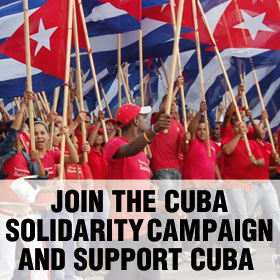Naval blockade of Cuba
Struggle La Lucha | Monday, 14 April 2025 | Click here for original article
No shipping company was willing to make the direct voyage to the port of Mariel in Cuba for fear of US sanctions, according to a report published by the daily Granma which addressed specific examples of the US blockade of the island. A test container was sent to evaluate the costs, via a much longer itinerary, which included several stops at ports in China. The voyage began on February 18, 2024, and ended on May 3, 75 days later. According to estimates, transporting the full cargo along this route would cost $9.7 million.
The African country, in solidarity, could not afford such a sum and decided to sell the 3,000 tons of horse mackerel and use the money to buy frozen fish in a port near Cuba. “The money raised was only enough to buy 386 tons in nearby waters,” says Granma.
The sophistication of the blockade has reached indescribable levels, with measures to frighten shipping companies and make it increasingly difficult for cargo to arrive by sea in Cuba, which, after all, has no other means of regular trade for large containers of food and fuel. What was previously prevented by warships patrolling territorial waters is now made impossible by sanctions, regulations and legal threats that turn every Cuban port into a risk zone for any shipping company.
In 2024, an amendment to the US National Defense Authorization Act established that any port under the jurisdiction of a government considered to be a state sponsor of terrorism, as is the case of Cuba according to Washington’s unfounded accusations, will be evaluated as a port with insufficient security measures. Therefore, US customs controls, which were already very strict (any ship arriving on the island had to wait six months to travel to the US), were tightened. The 2024 regulations apply to all commercial vessels arriving in US territory after having visited Cuban ports, with the exception of those that have docked at the Guantanamo Naval Base.
Last week another bombshell went under the media radar, a common practice of the US administration, which has the world turned upside down with the tariff war, while the State Department’s little wars are carried out with equal perfidy but greater stealth. Thus they established special conditions for all commercial ships that have visited Cuban ports on their last five stopovers before reaching US territory. Even those that comply with this requirement will be subject to special surveillance, they will be guarded by coastguards and the guards must have total visibility of the exterior of the ship, both on the land and sea sides.
Apart from the new blow aimed at shipping companies that dared to trade with the island and carry a test container with horse mackerel, the new measure nips in the bud the transportation from the US of food, electrical appliances and cars that were allowed during the Biden administration, under one-sided conditions and operated by the private sector in Cuba. The measures are aimed at further deteriorating cooperative ties on security issues and increasing the extraterritoriality of the blockade.
The difference between the direct naval blockade and this one is purely formal: if before a military vessel was enough to prevent trade, today the threat induced through a sanctions system that suffocates as much or more is enough, without the need for a single gunboat.
This week the White House special envoy for Latin America, Mauricio Claver-Carone, acknowledged in Miami that the Trump administration is taking a “more surgical” approach against the government of Miguel Díaz-Canel, with the aim of strangling the Cuban economy. What he does not say is that this cruelty has a direct impact on the civilian population and leaves unbearable images linked to an increasingly precarious daily life in Cuba, where not even the horse mackerel escapes.






